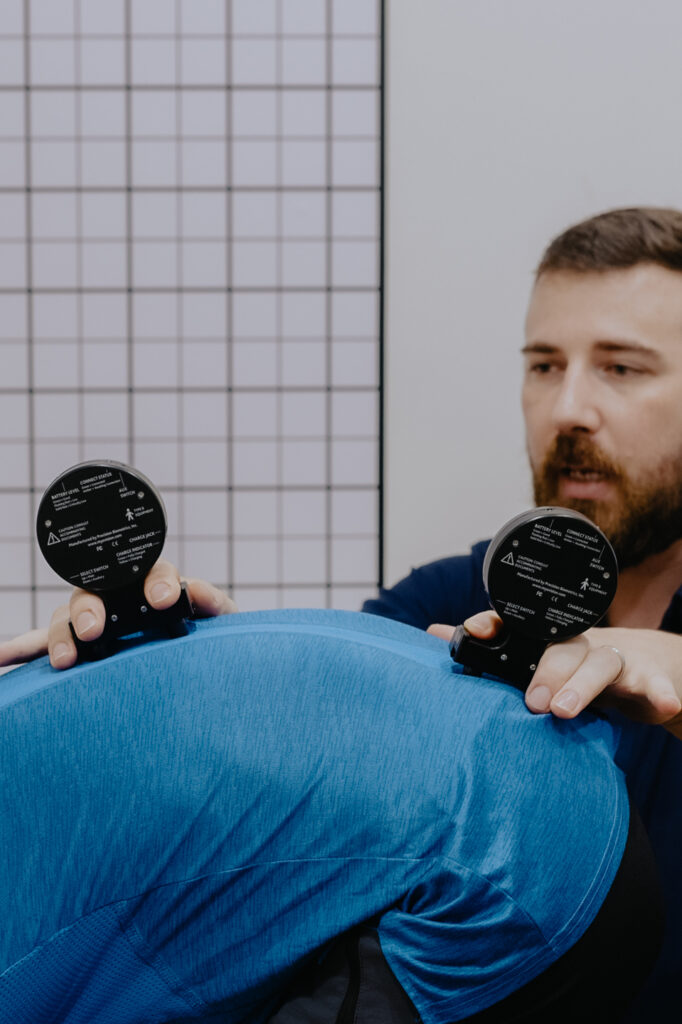Chiropractic care is a healthcare discipline that focuses on diagnosing and treating neuromusculoskeletal disorders, primarily those related to the spine. Chiropractors use manual techniques, such as spinal adjustments and joint manipulation, to correct misalignments, improve nerve function, and promote overall health. This non-invasive approach aims to alleviate pain, improve mobility, and enhance the body’s natural ability to heal itself.
Chiropractic care is often sought for conditions like back pain, neck pain, headaches, and issues related to the nervous system.

Chiropractors commonly perform spinal adjustments, which can produce a popping or cracking sound.
This sound is often mistaken for bones cracking, but it actually results from the release of gas bubbles within the joint fluid. The purpose of these adjustments is to restore proper alignment, reduce pain, and improve joint function.
Our chiropractors here at Chiropractic Singapore undergo extensive training to perform these adjustments safely and effectively.

While some people can self-adjust their joints, it's important to note that self-manipulation may not provide the same benefits as professional chiropractic care.
Chiropractors are trained to assess your condition, diagnose underlying issues, and apply precise techniques to address specific problems. Self-adjustment may provide temporary relief but can also be risky if done incorrectly, potentially causing injury.
Our chiropractors offer a tailored approach based on your unique needs, ensuring more comprehensive and effective care.
The cost of chiropractic care in Singapore can vary based on factors such as the chiropractor’s experience, the clinic’s location, and the complexity of your condition. On average, a single chiropractic session may range from SGD 80 to SGD 150 or more. Initial consultations might be slightly more expensive due to assessments and evaluations.
It’s advisable to discuss pricing and payment options during your initial consultation to get a clear understanding of the costs associated with your specific care plan.

Chiropractic care is typically not covered by the standard MediShield or Integrated Shield Plans (IP) in Singapore.
However, some private health insurance policies or employee benefit packages may offer coverage for chiropractic care. It's essential to check with your insurance provider to determine if chiropractic care is included in your policy and to what extent. Be prepared to provide proper documentation and receipts for reimbursement if applicable.
Selecting the right chiropractor in Singapore is essential for receiving safe and effective care.
Here are some steps to help you make an informed choice:

When evaluating chiropractors and clinics, keep the following factors in mind:
During your chiropractic consultation, it’s important to gather essential information. Here are some questions to consider asking:
Chiropractic care is primarily focused on the musculoskeletal system and its relationship with overall health and wellness. Chiropractors use hands-on spinal adjustments and other manual techniques to help improve joint function, alleviate pain, and promote the body’s natural ability to heal itself. While chiropractic care may not be a cure-all, it has been found to be helpful in managing or improving various conditions, including:
It’s important to note that the effectiveness of chiropractic care can vary from person to person, and not all conditions can be resolved through chiropractic care alone. Additionally, chiropractors often work in conjunction with other healthcare professionals to provide comprehensive care when needed. If you’re considering chiropractic care for a specific condition, consult with a qualified chiropractor and discuss your individual needs and goals.
Chiropractic care is suitable for people of all ages, from infants to seniors. Additionally, it can benefit individuals with acute or chronic musculoskeletal conditions. It is often sought by those looking for a non-invasive and drug-free approach to pain management and overall wellness.
A chiropractic adjustment, also known as spinal manipulation, is a non-invasive manual procedure performed by chiropractors.
It involves the application of controlled force to a specific joint in the spine, with the goal of improving joint mobility, reducing pain, and restoring proper function to the musculoskeletal system.
Chiropractors use their hands or specialized instruments to apply a quick and controlled thrust to the targeted joint, which can result in an audible “pop” or “crack” sound.
There are various chiropractic adjustment techniques, and the choice of technique depends on the patient’s condition, preferences, and the chiropractor’s expertise. Some common chiropractic adjustment techniques include:
This is the most traditional and widely used technique, involving manual adjustments where the chiropractor uses their hands to apply a quick, controlled thrust to a specific joint or vertebra.
Chiropractors may use a handheld instrument called an Activator to deliver gentle, low-force adjustments to the spine or joints.
This technique involves precise assessment and adjustments to specific spinal segments to address misalignments.
Patients lie on a specialised table with drop sections, allowing the chiropractor to apply a low-force thrust to the spine.
Often used for conditions like herniated discs, this technique involves a gentle, rhythmic pumping motion to decompress and mobilise the spine.
Chiropractors use handheld stainless steel instruments to perform soft tissue mobilisation and alleviate muscle and connective tissue restrictions.
Chiropractors may use a variety of tools and equipment to assist in chiropractic adjustments, including:
Specialised tables with movable sections and drop mechanisms to aid in adjustments and patient comfort.
A handheld device that delivers controlled, low-force adjustments.
To aid in diagnosis and treatment planning, chiropractors may use X-rays or other imaging techniques.
Chiropractic care and bone setting are related but distinct practices. Chiropractic care primarily focuses on the alignment and manipulation of the spine and musculoskeletal system to improve overall health and alleviate various conditions, including back pain, neck pain, and headaches. Chiropractors often use spinal adjustments as a key modality.
Bone setting, on the other hand, is a traditional practice that involves manually manipulating bones and joints to treat fractures, dislocations, and other orthopaedic issues. It is often performed by traditional healers or practitioners with expertise in bone setting techniques. While there may be some overlap in techniques, chiropractic care is a more comprehensive approach aimed at addressing a wider range of musculoskeletal conditions and promoting overall wellness.
It’s essential to consult with healthcare professionals and discuss your specific condition and goals to determine which alternative modality is most suitable for your needs. Additionally, the effectiveness of these modalities may vary from person to person, so individual results can vary.
Chiropractic adjustments are generally not painful. Most patients report feeling some discomfort or pressure during the adjustment, but it is typically not painful.
In fact, many patients experience relief from pain and improved mobility following an adjustment. Chiropractors are trained to use the appropriate amount of force and precision to ensure the comfort and safety of their patients.
It’s important to communicate openly with your chiropractor about any discomfort or concerns you may have during the adjustment, so they can make necessary adjustments to the technique or pressure applied.
Some soreness or mild discomfort after an adjustment is normal and usually temporary, akin to the sensation you might feel after exercising or stretching.
Chiropractic care can sometimes be appropriate after surgery, but it depends on the type of surgery, your individual condition, and your surgeon’s recommendations. You should always inform your chiropractor about any past surgeries and provide them with your medical history. In some cases, chiropractic adjustments may be contraindicated, especially if there are surgical implants, recent surgical wounds, or specific medical conditions that require caution.
Your chiropractor will work closely with your healthcare team to ensure any adjustments are safe and appropriate for your post-surgery recovery.
Chiropractic care can be safe and beneficial for pregnant women when performed by a qualified chiropractor experienced in prenatal care. Pregnancy can cause musculoskeletal changes and discomfort, such as back pain and sciatica.
Chiropractic adjustments may help alleviate these issues and improve overall comfort during pregnancy.
Chiropractors trained in prenatal care use gentle and pregnancy-specific techniques to ensure safety for both the mother and the baby. Always consult with your obstetrician or healthcare provider before seeking chiropractic care during pregnancy to ensure it is suitable for your unique situation.
Chiropractic care for babies and children can be safe when provided by a qualified and experienced chiropractor.
Some parents seek chiropractic care for their children to address issues like colic, ear infections, or musculoskeletal concerns. Paediatric chiropractors use gentle and age-appropriate techniques, often significantly different from those used on adults.
It’s essential to choose a chiropractor who has experience in paediatric care and consult with your child’s paediatrician before starting any chiropractic adjustments. The safety and appropriateness of chiropractic care for children depend on their specific health conditions and needs.
Chiropractic care can be safe for the elderly when administered by a qualified and experienced practitioner who is aware of the unique needs and conditions that can affect older individuals.
However, it’s essential for seniors to consult with their healthcare providers and ensure that chiropractic care is appropriate for their specific health concerns.
Chiropractic adjustments may provide relief from certain musculoskeletal issues, but the practitioner should conduct a thorough assessment and adjust the techniques to accommodate the elderly individual’s frailty, osteoporosis, or other age-related factors to ensure safety and effectiveness.

If it’s your first time visiting a chiropractor, here’s a step-by-step guide to help you understand the process:
 As you arrive at our centre, expect minimal wait times, typically just enough to complete your initial paperwork. This paperwork is essential for our health partners and your attending chiropractor to gain insight into your health history and current needs. We recommend arriving 10 minutes before your appointment to complete this paperwork.
As you arrive at our centre, expect minimal wait times, typically just enough to complete your initial paperwork. This paperwork is essential for our health partners and your attending chiropractor to gain insight into your health history and current needs. We recommend arriving 10 minutes before your appointment to complete this paperwork.
 The initial consultation, lasting approximately 20 minutes, is a crucial phase in your chiropractic journey. During this comprehensive spinal check-up, your chiropractor will focus on understanding your condition and concerns.
The initial consultation, lasting approximately 20 minutes, is a crucial phase in your chiropractic journey. During this comprehensive spinal check-up, your chiropractor will focus on understanding your condition and concerns.
They will explain the causes of joint dysfunction, the role of chiropractic adjustments, and the numerous benefits chiropractic care can provide. If you’ve never had your spine assessed before, this is the perfect opportunity to have your questions answered by the chiropractor. Following this, a series of tests will be conducted to gain a holistic understanding of your spinal health.
 Your chiropractor will perform a physical examination and palpation of your spine. Our friendly health partners will then conduct additional spinal examinations, including:
Your chiropractor will perform a physical examination and palpation of your spine. Our friendly health partners will then conduct additional spinal examinations, including:
 Based on the initial consultation and examinations, our chiropractors may recommend spinal X-rays to assess the severity and degree of degeneration in your spine. This step is crucial for your safety and ensures that the chiropractor has a comprehensive understanding of your condition.
Based on the initial consultation and examinations, our chiropractors may recommend spinal X-rays to assess the severity and degree of degeneration in your spine. This step is crucial for your safety and ensures that the chiropractor has a comprehensive understanding of your condition.
 After your X-rays have been taken, you’ll return for a second consultation with the chiropractor to review the results of your tests and X-rays. This session typically lasts about 45 minutes and includes a discussion of whether chiropractic care can offer relief for your condition or if other specialists should be considered.
After your X-rays have been taken, you’ll return for a second consultation with the chiropractor to review the results of your tests and X-rays. This session typically lasts about 45 minutes and includes a discussion of whether chiropractic care can offer relief for your condition or if other specialists should be considered.
If chiropractic care is recommended, the chiropractor will perform adjustments during this session and provide their personalised recommendation for your condition.
 Our chiropractic spinal check-up is exclusively focused on assessment and does not include adjustments. We are dedicated to providing personalised care, understanding that not everyone is suited for adjustments. By omitting adjustments from our check-ups, we prioritise your well-being, ensuring you only pay for services tailored to your needs and avoiding charges for services that may not be safe or necessary for you.
Our chiropractic spinal check-up is exclusively focused on assessment and does not include adjustments. We are dedicated to providing personalised care, understanding that not everyone is suited for adjustments. By omitting adjustments from our check-ups, we prioritise your well-being, ensuring you only pay for services tailored to your needs and avoiding charges for services that may not be safe or necessary for you.
If adjustments are recommended based on the assessment results, they are discussed and scheduled separately after the check-up. This approach allows you to make informed decisions about your care, ensuring a customised and effective chiropractic experience.
 If you opt for regular adjustments, our team will work with you to create a schedule for weekly or monthly visits, kickstarting your pain relief journey. Your journey to wellness begins here!
If you opt for regular adjustments, our team will work with you to create a schedule for weekly or monthly visits, kickstarting your pain relief journey. Your journey to wellness begins here!
The purpose of a spinal check-up is to evaluate the health and function of your spine and nervous system. Chiropractors focus on identifying and correcting subluxations (misalignments) in the spine that may interfere with nerve function. This can help improve overall health and well-being, alleviate pain, and enhance the body’s ability to heal itself.
The duration of an initial spinal check-up can vary but typically takes around 30 minutes to an hour, depending on the complexity of your condition and the thoroughness of the examination.
Chiropractors may use various tools and assessment methods, including their hands for palpation, orthopaedic and neurological tests, postural analysis, and sometimes imaging techniques like X-rays, to evaluate the spine and identify issues that need attention.
X-rays are sometimes used in chiropractic care to provide a detailed view of the spine’s structure and alignment. They can help chiropractors identify specific misalignments or structural issues that may not be apparent through physical examination alone.
Whether you need a new X-ray or can use an old one depends on several factors, including the age of the previous X-ray, your current health condition, and the chiropractor’s judgement. In some cases, a new X-ray may be necessary to accurately assess your current spinal condition.
Yes, chiropractic care often involves re-assessments and check-ups. After the initial evaluation, chiropractors develop a care plan tailored to your needs. Periodic re-assessments allow them to track your progress, make necessary adjustments to the care plan, and ensure that you are responding positively to the care.
The number of chiropractic adjustments needed varies from person to person and depends on factors such as your condition’s severity, how well you respond to the adjustments, and your health goals. Your chiropractor will discuss your individual care plan with you.
A chiropractic care plan typically includes a schedule of adjustments and any additional therapies or exercises deemed necessary by the chiropractor. The plan is tailored to address your specific needs and health goals.
Ad-hoc chiropractic adjustments refer to sporadic or as-needed visits to a chiropractor for immediate relief from pain or discomfort. In contrast, a care plan is a structured and comprehensive approach to chiropractic care that involves a predetermined schedule of adjustments and therapies aimed at addressing underlying issues, promoting long-term wellness, and preventing future problems. Care plans are typically designed to provide ongoing, proactive care rather than just addressing acute symptoms.
Enjoy $55 off your first check-up (U.P. $105) using the promo code ONLINE50 at check-out.
Enter your e-mail to start the booking process.
Note: X-rays and the first adjustment are not included in this promotion. For the safety of our patients, there will be no adjustments during the first visit.
CELEBRATE WORLD HEALTH DAY WITH US
Enjoy $67 off your first check-up (U.P. $105) using the promo code HEALTH38 at check-out.
Enter your e-mail to start the booking process.
Note: X-rays and the first adjustment are not included in this promotion. For the safety of our patients, there will be no adjustments during the first visit.